Step-by-step technology for growing sorghum from seed preparation to harvesting
Sorghum is a feed, food and industrial crop with enormous potential. In addition to being unpretentious, the plant is characterized by high productivity and has a lot of useful properties, so it is used everywhere. The stable demand for sorghum forces successful and beginning farmers to pay close attention to it.
What is sorghum
Sorghum is a multi-purpose grain crop. It has a powerful root system - secondary roots appear when three leaves grow. At the stage of 5-6 leaves, the plant produces new shoots, and at 7-8 leaves, intensive growth of the stem begins, which slows down at the moment the panicle emerges.
The flowering period of the corolla is 7-10 days. One panicle contains one female and two male flowers. The fruit is covered grains of white, yellow, brown color, small in size, millet-like.
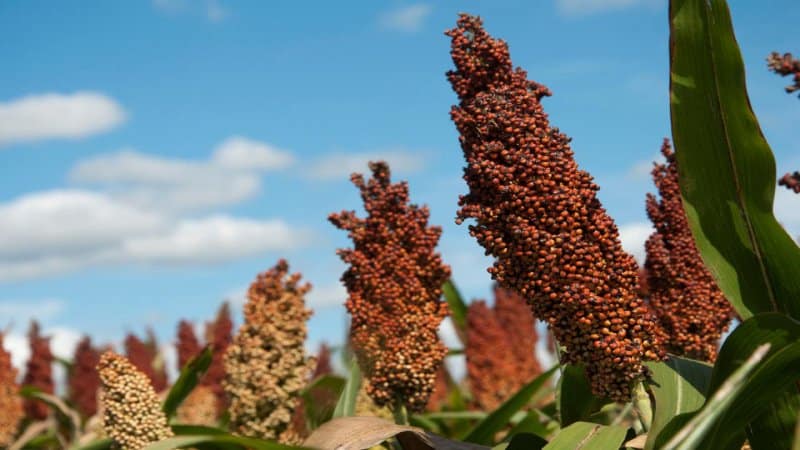
When cultivating crops, leading farms receive:
- high quality grain for preparing feed mixtures for farm animals, including poultry and cattle;
- green mass for preparing granulated feed when harvesting at the stage of milky-wax ripeness;
- to create annual pastures, since sugar green mass is used for making silage and haylage;
- to produce sugar syrup with a sugar content of up to 15-20%;
- high quality grain for feeding people with gluten intolerance;
- as a technical culture for making brooms and brushes.
When cut, the sorghum stem does not stop growing and grows again - it produces regrowth. The greatest amount of green mass is produced by sorghum-sudan hybrids and sugar varieties.
What are the features of its cultivation?
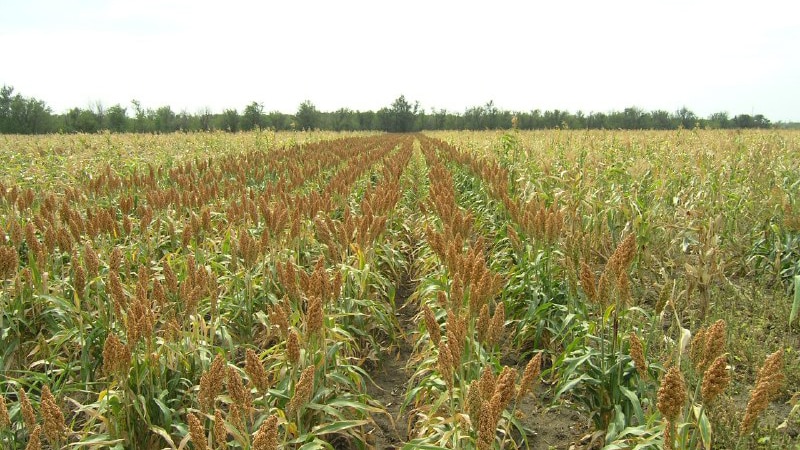
It is one of the most heat-loving and heat-resistant plants from the grains of the second group, which is not surprising. Northeast Africa is considered to be its homeland. Today, the bulk of sorghum is produced by farmers from the arid regions of the USA, Mexico, Nigeria, and India.
The crop is recommended for cultivation by domestic farmers in the southern and south-eastern regions of Russia. High drought resistance and undemanding quality of soil make it a universal replacement for corn, barley and other types of grains grown for silage.
On a note! Currently, sorghum is grown in 85 countries around the world, on all inhabited continents.
Types of sorghum

Depending on the intended economic use, four types of cultivated sorghum are distinguished:
- Broom with a dry, white, stemless core, 160-270 cm high. Used for making brooms (up to 5,000 pieces per hectare). The grain is difficult to collapse and suitable for foraging.
- Herbaceous or Sudan grass 2-2.4 m high, with strong bushiness (up to 15-16 stems per plant). The core of the stem is semi-dry or juicy, the grain is elongated, oblong. Used to produce green food for pets.
- Sugar with very juicy stems and increased bushiness, up to 3 m high. The grain is difficult to hull. It is used to produce sugar, molasses, ethanol, biogas, green mass, silage granules, grass meal.
- Grain with low, about 80-90 cm, stems and a well-grained panicle up to 35 cm long. It is divided into yellow-seeded and white-seeded.The grain collapses well. Suitable for harvesting for cereals, foraging, and making monofodder. The leafy mass is used for laying late silage.
Each species differs in its morphological characteristics and biological properties and has its own cultivation technology. In general, the agricultural technology for cultivating millet is similar to that for cultivating millet.
Rules for crop rotation when growing sorghum
Like any grain crop, sorghum is demanding on its predecessors. This feature is explained by the long growing season of any species. In the first 30-35 days, crop seedlings are weakly competitive with respect to weeds.
As the practice of the largest exporter of sorghum, the United States, shows, the crop produces the best yields after legumes, especially soybeans. Fields after vegetable and oilseed crops (mustard, cabbage, early potatoes, zucchini and others) are also chosen for sorghum sowing. It is not recommended to plant the crop after sunflower and Sudanese grass.
In fact, sorghum occupies the same place in the crop rotation as corn, after which all grains grow well. The explanation for this is simple - their strong root system intensively loosens the soil and allows grains to unhindered take root to the required depth.
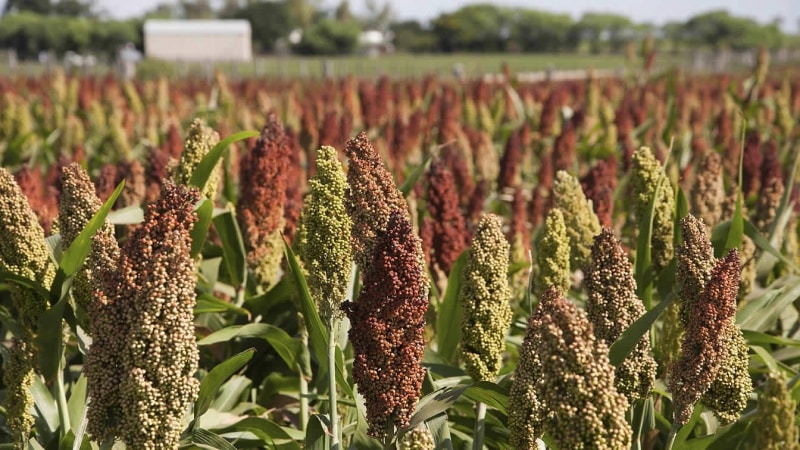
Preparation
The main requirement for areas for sorghum sowing is high levels of accumulated moisture and the absence of weeds. The most effective method of creating such conditions is considered to be earlier spring harrowing.
The main requirement for growing technology is the creation of a dense seed bed, which will ensure uniform germination.
Sowing is carried out with quality seeds after dressing with Baitan or Vitavax preparations at the rate of 2 kg of the drug per ton of grain to protect against fungal and other diseases.
Landing
The best results when cultivating the crop are achieved with deep fall plowing of the site.
Mandatory pre-sowing measures include treating the soil with glyphosphate-based preparations at a rate of 2 l/ha to kill weeds.
Sowing dates
Sorghum is a heat-demanding crop. When sown in insufficiently warmed soil, the seeds rot and do not germinate.
Planting is carried out when the seed layer, about 5-6 cm thick, has completely warmed up to a temperature of 12-14°C. Approximately - the first or second ten days of May in irrigated areas, mid-end of April in non-irrigated areas.
Seeding rate
The best yields are achieved when sowing to a depth of 5-7 cm and a row spacing of 50-55 cm. In such conditions, the seeding rate is 14-15 kg of grain per 1 ha with an expected density of 155-160 thousand plants per 1 ha.
Sowing instructions
Sowing includes the required steps:
- Simultaneous application of diammophoska along with planting seed material. Immediately after sowing, a herbicide such as Primextra TZ Gold 500 is introduced at a rate of 4.5 l/ha, subject to the pre-sowing application of the Concept 3 antidote (according to the instructions).
- Rolling with ring rollers to mulch the soil.
- Pre-emergence harrowing with medium harrows after five days to destroy 60-70% of weeds.
Further care
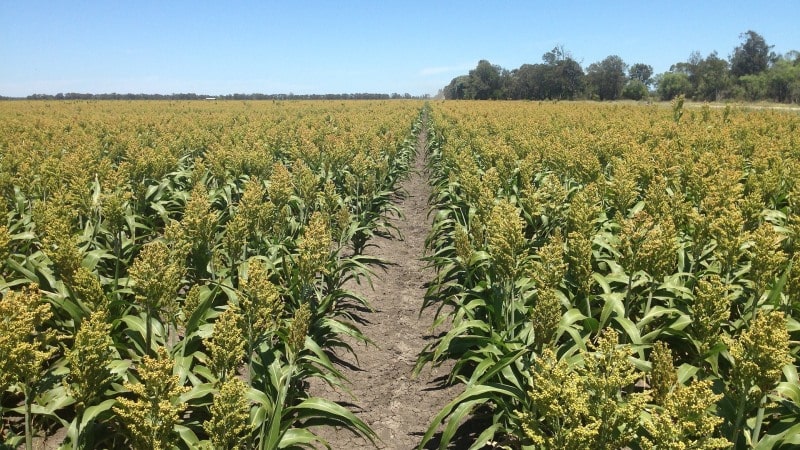
The biggest challenge farmers face in sorghum cultivation is weed control. Like all millet breads, sorghum has a protracted growing season and is suppressed by weeds within 4-5 weeks after the appearance of the first shoots.
When the rows are clearly marked, inter-row cultivation is carried out to a depth of 10-12 cm, after 20-22 days - to a depth of 8-10 cm, after 45-50 days - to a depth of 6-8 cm.
Sorghum is highly responsive to organic and mineral fertilizers. In the spring, when sowing, 10-20 t/ha of manure is applied, dripping away from the seeds. Most of the mineral fertilizers are applied under fall plowing, but 10-15 kg/ha of phosphorus in the form of granular superphosphate is left for application to the rows during sowing.
Disease and pest control
The most dangerous pest of sorghum in the Russian Federation is the cereal aphid. To combat insects, insecticides are used: “BI-58 New” - 1 l/ha, “Nurel D” - 0.7 l/ha, “Karate Zeon” - 0.2 l/ha with a consumption rate.
Fusarium sorghum grain, which contains mycotoxins in large quantities, is absolutely unsuitable. To prevent infection by fungi, the seed must be treated before sowing with Vitavax or Baitan, and any living residues must be destroyed in a timely manner.
Harvest and storage
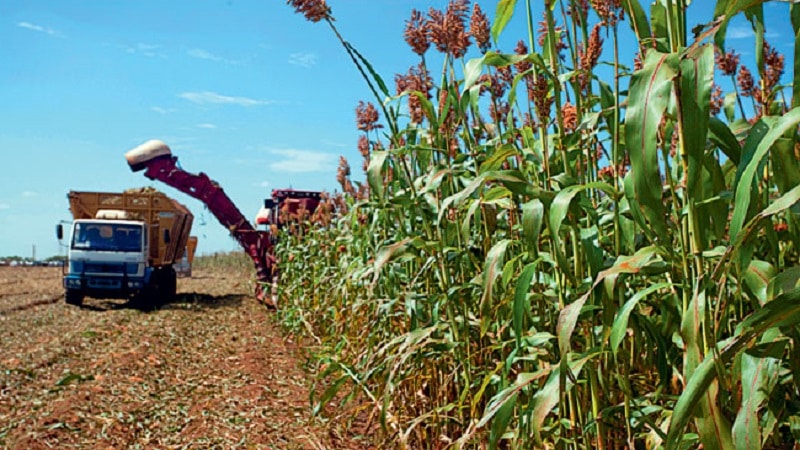
The farmer faces the greatest risks when harvesting grain sorghum during periods of sudden, prolonged rains due to the risk of crop shedding and rotting.
The timing of sorghum collection directly depends on its type and intended purpose:
- Sorghum is harvested for grain in September - when full ripeness is achieved using direct combining at a speed of 500-600 drum revolutions per minute.
- Broom sorghum is harvested at the end of August - at the end of the stage of waxy ripeness of the grain, the upper part is cut off to a height of 60-65 cm and then the grain is combed out.
- Sorghum is harvested for green mass at the moment the panicle is thrown out, before the stems become coarser - from the first days of July to the end of August. On average, 2-3 cuttings of green mass are obtained per season with an interval of 40-45 days.
During the entire storage period of sorghum, it is important to organize constant ventilation of the grain to prevent moisture. Ventilation is carried out from the moment when the average air temperature over three days in the hangar becomes 5-8°C lower than the temperature of the grain mass.
Productivity per 1 ha
In arid regions, the expected sorghum grain yield of 2.5-3.5 t/ha is realized in full under non-irrigated conditions.
Integrated mechanization of cultivation
Sowing sorghum using No-Till technology is carried out using a Boss Ag seeder with the simultaneous application of ammonia.
Sorghum is sowed using a grain or row-crop seeder, John Deere type, with a working width of 3 m and an expected sowing speed of 8-9 km/h, when cultivated using traditional technology.
After germination, harrowing is carried out only with light harrows ZBP-06 or special mesh harrows BS-2, or wire harrows BP-5.4, BPN-4.2, or ZBPN-4.
To eliminate crust after heavy rains, rotary hoes ZMB-2.1, MB-2.8 or MVN-2.8 are used.
Sorghum is harvested using a grain header with a rigid cutter bar or a row crop header.
Conclusion
With minimal costs for fertilizing and cultivating the soil, sorghum allows you to harvest consistently high yields. The crop deserves the greatest attention from farms in the Russian Federation located in hot, arid regions.
The scope of sorghum is wide - from use as fodder to consumption. This means that the demand for products will grow steadily in the coming years.
Thank you, very interesting information.